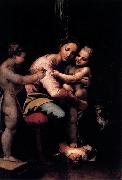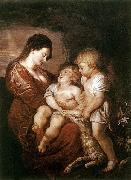Wholesale Oil Painting No Minimum |
|||||||||||
|
|
|||||||||||

|
|||||||||||
|
|
|
||||||||
Giulio RomanoItalian 1492-1546 Giulio Romano was born in Rome. In his native city, as a young assistant in Raphael's studio, he worked on the frescos in the Vatican loggias to designs by Raphael and in Raphael's Stanze in the Vatican painted a group of figures in the Fire in the Borgo (L'incendio di Borgo) fresco. He also collaborated on the decoration of the ceiling of the Villa Farnesina. After the death of Raphael in 1520, he helped complete the Vatican frescoes of the life of Constantine as well as Raphael's Coronation of the Virgin and the Transfiguration in the Vatican. In Rome, Giulio decorated the Villa Madama for Cardinal Giuliano de' Medici, afterwards Clement VII. The crowded Giulio Romano frescoes lack the stately and serene simplicity of his master. In the Palazzo Te, MantuaAfter the Sack of Rome in 1527 and the death of Leo X, artistic patronage in Rome slackened. Vasari tells how Baldassare Castiglione was delegated by Federico Gonzaga to procure Giulio to execute paintings and architectural and engineering projects for the duchy of Mantua. His masterpiece of architecture and fresco painting in that city is the suburban Palazzo Te, with its famous illusionistic frescos (c. 1525?C1535). He also helped rebuild the ducal palace in Mantua, reconstructed the cathedral, and designed the nearby Church of San Benedetto. Sections of Mantua that had been flood-prone were refurbished under Giulio's direction, and the duke's patronage and friendship never faltered: Giulio's annual income amounted to more than 1000 ducats. His studio became a popular school of art. |
||||||||
|
|
||||||||
Virgin and Child with the Infant St John
Virgin and Child with the Infant St John Painting ID:: 83588 |
Date ca. 1523(1523)
Medium Oil on wood
Dimensions Height: 126 cm (49.6 in). Width: 85 cm (33.5 in).
cjr Date ca. 1523(1523) Medium Oil on wood Dimensions Height: 126 cm (49.6 in). Width: 85 cm (33.5 in). cjr |
|||||||
|
|
||||||||
Giulio RomanoItalian 1492-1546 Giulio Romano was born in Rome. In his native city, as a young assistant in Raphael's studio, he worked on the frescos in the Vatican loggias to designs by Raphael and in Raphael's Stanze in the Vatican painted a group of figures in the Fire in the Borgo (L'incendio di Borgo) fresco. He also collaborated on the decoration of the ceiling of the Villa Farnesina. After the death of Raphael in 1520, he helped complete the Vatican frescoes of the life of Constantine as well as Raphael's Coronation of the Virgin and the Transfiguration in the Vatican. In Rome, Giulio decorated the Villa Madama for Cardinal Giuliano de' Medici, afterwards Clement VII. The crowded Giulio Romano frescoes lack the stately and serene simplicity of his master. In the Palazzo Te, MantuaAfter the Sack of Rome in 1527 and the death of Leo X, artistic patronage in Rome slackened. Vasari tells how Baldassare Castiglione was delegated by Federico Gonzaga to procure Giulio to execute paintings and architectural and engineering projects for the duchy of Mantua. His masterpiece of architecture and fresco painting in that city is the suburban Palazzo Te, with its famous illusionistic frescos (c. 1525?C1535). He also helped rebuild the ducal palace in Mantua, reconstructed the cathedral, and designed the nearby Church of San Benedetto. Sections of Mantua that had been flood-prone were refurbished under Giulio's direction, and the duke's patronage and friendship never faltered: Giulio's annual income amounted to more than 1000 ducats. His studio became a popular school of art. |
||||||||
|
|
||||||||
|
|
Virgin and Child with the Infant St John
Virgin and Child with the Infant St John Painting ID:: 87418 |
1523(1523)
Medium Oil on wood
cyf 1523(1523) Medium Oil on wood cyf |
||||||
|
|
||||||||
Peter Paul RubensFlemish Baroque Era Painter, 1577-1640 Peter Paul Rubens (June 28, 1577 ?C May 30, 1640) was a prolific seventeenth-century Flemish Baroque painter, and a proponent of an exuberant Baroque style that emphasized movement, color, and sensuality. He is well-known for his Counter-Reformation altarpieces, portraits, landscapes, and history paintings of mythological and allegorical subjects. In addition to running a large studio in Antwerp which produced paintings popular with nobility and art collectors throughout Europe, Rubens was a classically-educated humanist scholar, art collector, and diplomat who was knighted by both Philip IV, king of Spain, and Charles I, king of England. Rubens was a prolific artist. His commissioned works were mostly religious subjects, "history" paintings, which included mythological subjects, and hunt scenes. He painted portraits, especially of friends, and self-portraits, and in later life painted several landscapes. Rubens designed tapestries and prints, as well as his own house. He also oversaw the ephemeral decorations of the Joyous Entry into Antwerp by the Cardinal-Infante Ferdinand in 1635. His drawings are mostly extremely forceful but not detailed; he also made great use of oil sketches as preparatory studies. He was one of the last major artists to make consistent use of wooden panels as a support medium, even for very large works, but he used canvas as well, especially when the work needed to be sent a long distance. For altarpieces he sometimes painted on slate to reduce reflection problems. His fondness of painting full-figured women gave rise to the terms 'Rubensian' or 'Rubenesque' for plus-sized women. The term 'Rubensiaans' is also commonly used in Dutch to denote such women. |
||||||||
|
|
||||||||
|
|
Virgin and Child with the Infant St John
Virgin and Child with the Infant St John Painting ID:: 87505 |
first half of 17th century
Medium Oil on paper fixed onto canvas
cyf first half of 17th century Medium Oil on paper fixed onto canvas cyf |
||||||
|
|
||||||||
|
Peter Paul Rubens Flemish Baroque Era Painter, 1577-1640 Peter Paul Rubens (June 28, 1577 ?C May 30, 1640) was a prolific seventeenth-century Flemish Baroque painter, and a proponent of an exuberant Baroque style that emphasized movement, color, and sensuality. He is well-known for his Counter-Reformation altarpieces, portraits, landscapes, and history paintings of mythological and allegorical subjects. In addition to running a large studio in Antwerp which produced paintings popular with nobility and art collectors throughout Europe, Rubens was a classically-educated humanist scholar, art collector, and diplomat who was knighted by both Philip IV, king of Spain, and Charles I, king of England. Rubens was a prolific artist. His commissioned works were mostly religious subjects, "history" paintings, which included mythological subjects, and hunt scenes. He painted portraits, especially of friends, and self-portraits, and in later life painted several landscapes. Rubens designed tapestries and prints, as well as his own house. He also oversaw the ephemeral decorations of the Joyous Entry into Antwerp by the Cardinal-Infante Ferdinand in 1635. His drawings are mostly extremely forceful but not detailed; he also made great use of oil sketches as preparatory studies. He was one of the last major artists to make consistent use of wooden panels as a support medium, even for very large works, but he used canvas as well, especially when the work needed to be sent a long distance. For altarpieces he sometimes painted on slate to reduce reflection problems. His fondness of painting full-figured women gave rise to the terms 'Rubensian' or 'Rubenesque' for plus-sized women. The term 'Rubensiaans' is also commonly used in Dutch to denote such women. Virgin and Child with the Infant St John first half of 17th century Medium Oil on paper fixed onto canvas cyf |
||||||||
|
|
||||||||
|
Prev Next
|
||||||||
|
|
||||||||
|
Related Paintings to Peter Paul Rubens :. |
||||||||
|
|
||||||||
|
CONTACT US |



